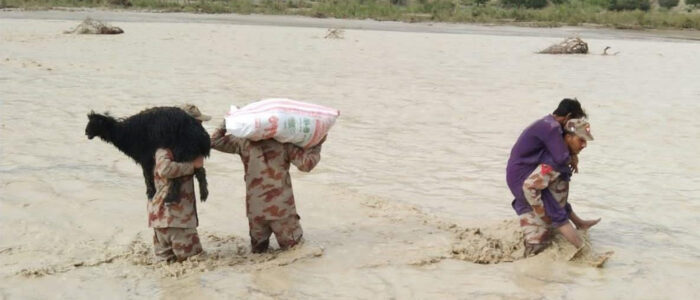The recent monsoon in Pakistan has led to unprecedented floods that have made the government of Pakistan announce a state of emergency. Balochistan, being the largest by area, faced a natural calamity barehanded. Though the level of catastrophe knocked on Pakistan was huge in magnitude, it has unveiled many administrative lacunas at the federal and provincial levels, with the early warning system and its ineffectiveness being one of them. In Balochistan, the floods wrecked bridges, homes, buildings, and highways in addition to destroying dams. The ruthless surges of the flash floods ruined the communications lines as well. The actual lines of contact between the provinces were cut off as a result. Due to bridge collapses and destroyed roadways throughout the provinces, there are concerns about imminent food scarcity. Balochistan also faced a suspension of train operations because of the bridge damage in the district of Bolan.
The recent floods in Pakistan have been connected to the phenomenon of climate change. Pakistan has been ranked as the eighth most vulnerable nation in the Climate Risk Index since 2000, according to a report by the German Watch Institute, a non-profit organisation that works on climate change concerns. Balochistan receives the least amount of rainfall each year. However, the province has received 411% more rain this year than the 30-year average. The general climate of Balochistan has standard features of droughts and dry, arid weather in the area. The latest heavy rainfall and flooding indicate a grave climate disaster. Flood risk has intensified as a result of climate change. Additionally, earthquakes are always a possibility in Balochistan because of the province’s location in one of the seismically active regions of the planet. Despite the vulnerability of Balochistan towards natural disasters, recent floods raised many questions for concerned authorities.
People of the region usually live on rough terrain and remote areas; keeping them informed on time is critical, especially in villages. Taking precautions like putting in place an early warning system effectively makes it feasible to lessen the risk and harm that such calamities cause. Besides, disaster preparedness has never been a top concern in Pakistan, despite institutional frameworks like the Provincial Disaster Management Authorities (PDMAs) and the National Disaster Management Authority (NDMA) at the federal and provincial levels, respectively. The National Climate Change Policy of Pakistan does refer to the need to establish early warning systems, evacuation plans, and strategies, but all seem in vain. However, the preparedness of NDMA and the PDMA, a number of government agencies, including those in charge of forestry, irrigation, and public health, are all responsible for some level of negligence.
Though the level of catastrophe knocked on Pakistan was huge in magnitude, it has unveiled many administrative lacunas at the federal and provincial levels, with the early warning system and its ineffectiveness being one of them.
Also, for the past few months, Pakistan has been struggling financially, and political polarisation has also worsened the situation at all levels. It seems that the PDM-led government took the time to concentrate on rhetoric formation against the PTI in recent months, yet the issue of probable floods was not heeded seriously despite the early warning system. Though it cannot be said that the rains were normal, these climate-induced floods could be tackled efficiently if coordination among the centre and provinces was appropriately ensured and executed. To reduce risks and losses, these institutions must effectively coordinate and plan.
The National Disaster Management Authority (NDMA) reports that more than 36,469 homes were damaged throughout Pakistan, with Balochistan accounting for 60% of the losses. The floods impacted about 800 schools, 600 of which were in Balochistan. The World Food Program estimates that 571 people died as a result of the nationwide floods. The highest number of casualties of any province, three for every ten, occurred in Balochistan. Over 2,000 acres of crops and other plants that were ready for harvest were destroyed in the Lasbela district alone.
Floods and other catastrophes will likely occur more frequently due to the ongoing climate crisis. Moreover, the lapses in the disaster management system, inadequate infrastructure, and vulnerable dwellings will amplify the destruction brought on by such dangers. Pakistan may be taken as an example in this regard. Statistics from Balochistan show that when natural disasters hit regions that are already vulnerable, they create more havoc.
Balochistan continues to be critical for the economic progress of Pakistan because of the Gwadar port and the China-Pakistan Economic Corridor. In order for processes to run smoothly, it is pertinent to take climate change and its impacts seriously; otherwise, all the infrastructure and development projects will remain prone to natural disasters like floods and earthquakes. After reviewing a regional report on the vulnerability to disasters such as floods and earthquakes, the Balochistan and federal governments must prioritise disaster management and early warning systems. The Chinese and other investments will not have any horizontal effect, particularly in Balochistan, until efforts are not put into place to block such disasters in the future.
